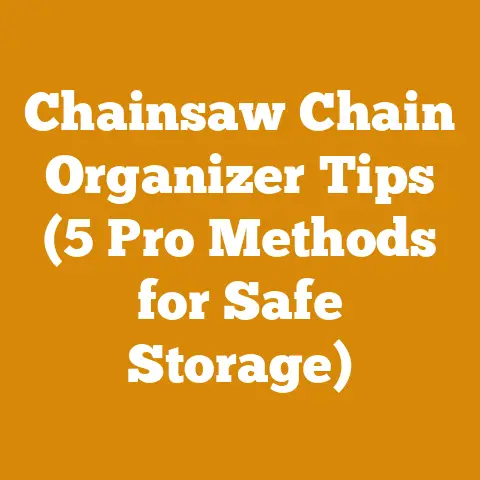Homemade Tree Pruning Sealer for Cuts & Damage (Pro Tips)
I’ve been there, staring at a freshly pruned tree limb, wondering if I really need to slather on some pruning sealer. The truth is, the decision to use a tree pruning sealer is one that many gardeners and arborists debate. It’s not as straightforward as you might think. And if you do decide to use one, the cost of commercial sealers can add up, especially if you’re pruning regularly. That’s where the idea of a homemade tree pruning sealer comes in. But is it a viable option? Does it actually work? And more importantly, how much will it really save you? Let’s dive into the world of homemade tree pruning sealers, weighing the pros, cons, costs, and the science behind it all.
Homemade Tree Pruning Sealer for Cuts & Damage (Pro Tips)
The question of whether or not to use a tree pruning sealer after making cuts or addressing damage is a complex one. While the old school of thought championed sealers as essential for protecting trees from disease and decay, modern arboriculture often takes a more nuanced approach. Understanding the benefits, risks, and real costs associated with both commercial and homemade solutions is key to making the right decision for your trees.
The Great Pruning Sealer Debate: To Seal or Not to Seal?
For years, the common wisdom was that every pruning cut needed to be sealed. The idea was simple: a barrier would prevent pathogens and insects from entering the wound, promoting faster healing and preventing decay. However, research has challenged this notion.
- The Argument Against Sealing: Many arborists now believe that trees possess natural defense mechanisms to seal wounds themselves. Sealing, in some cases, can actually trap moisture and create an environment conducive to fungal growth. Furthermore, some commercial sealers contain chemicals that can be harmful to the tree.
- The Argument For Sealing: There are still situations where sealing can be beneficial. For example, if a tree is known to be susceptible to specific diseases, or if the pruning cut is exceptionally large, a sealer might offer an extra layer of protection. Also, sealers can be useful in preventing certain insects from boring into the exposed wood.
- My Personal Experience: I’ve personally seen both sides of this. I once had a beautiful apple tree that suffered a significant branch break during a storm. I religiously sealed the wound with a commercial product, only to find years later that rot had developed underneath the sealant. On the other hand, I’ve also had trees with smaller pruning cuts that healed perfectly well without any sealer.
Understanding the Role of Tree Wound Healing
Before we get into homemade recipes, it’s important to understand how trees heal themselves. Trees don’t “heal” in the same way humans do. They don’t regenerate lost tissue. Instead, they compartmentalize the wound, creating a barrier to prevent decay from spreading. This process is called compartmentalization of decay in trees (CODIT).
- CODIT in Action: The tree forms a callus around the wound, gradually closing it off. The effectiveness of CODIT depends on several factors, including the tree’s species, age, health, and the size and location of the wound.
- The Importance of Proper Pruning: Clean, precise pruning cuts are crucial for promoting effective compartmentalization. Jagged or torn cuts are more difficult for the tree to seal.
- Factors Affecting Healing Time: A healthy tree will generally heal faster than a stressed or diseased one. The time of year also plays a role; trees tend to heal more quickly during their active growing season.
When to Consider Using a Pruning Sealer (Commercial or Homemade)
While sealing isn’t always necessary, here are some scenarios where it might be worth considering:
- Large Wounds: Cuts larger than 2 inches in diameter are more vulnerable to infection and decay.
- Susceptible Species: Some tree species are more prone to disease or insect infestation than others. For example, oak trees are susceptible to oak wilt, and using a sealer after pruning during certain times of the year can help prevent infection.
- Disease Presence: If there’s a known disease outbreak in your area, sealing pruning cuts might offer an extra layer of protection.
- Cosmetic Reasons: In some cases, you might want to use a sealer to improve the appearance of the wound, especially in ornamental trees.
Decoding Commercial Pruning Sealers: Costs and Considerations
Before we jump into the world of homemade solutions, let’s take a look at commercial pruning sealers.
- Types of Commercial Sealers: Commercial sealers come in various forms, including asphalt-based paints, aerosol sprays, and brush-on liquids.
- Cost Breakdown: The cost of commercial sealers can range from $10 to $30 per can or bottle, depending on the size and brand. Let’s break down the costs:
- Small Aerosol Can (12 oz): \$10 – \$15
- Quart of Brush-On Sealer: \$15 – \$25
- Gallon of Brush-On Sealer: \$25 – \$40
- Cost Over Time: If you’re pruning regularly, these costs can add up quickly. For example, if you use one quart of sealer per year, you’ll spend \$15-\$25 annually.
- Potential Hidden Costs: Some commercial sealers contain chemicals that can be harmful to the tree or the environment. It’s important to read the label carefully and choose a product that is safe and non-toxic.
- Environmental Impact: Consider the environmental impact of the sealer. Some products contain volatile organic compounds (VOCs) that contribute to air pollution.
- My Costly Mistake: I once bought a “bargain” sealer that turned out to be little more than black paint. It did nothing to protect the tree and actually hindered the healing process. I learned my lesson: quality matters.
Diving into Homemade Tree Pruning Sealer Recipes
Now, let’s get to the heart of the matter: homemade tree pruning sealers. The idea is to create a cost-effective and potentially more natural alternative to commercial products. But do they work? Let’s explore some popular recipes and their effectiveness.
Recipe 1: The Classic Clay and Water Paste
This is one of the oldest and simplest recipes.
- Ingredients:
- Natural clay (not pottery clay, but rather a type of soil with high clay content)
- Water
- Instructions:
- Mix the clay and water until you achieve a thick, paste-like consistency.
- Application: Apply the paste to the pruning cut with a brush or spatula.
- Pros:
- Inexpensive: Clay is readily available in many areas and is virtually free.
- Natural: No harmful chemicals.
- Cons:
- May not be very durable: The paste can crack and wash away in wet weather.
- Limited effectiveness: It doesn’t offer much protection against pathogens or insects.
- Cost Analysis: The cost of this recipe is negligible, assuming you have access to clay.
- My Experience: I’ve used this method on smaller cuts, mainly as a way to keep the wound from drying out too quickly. It’s not a miracle cure, but it’s a harmless option.
Recipe 2: The Beeswax and Resin Blend
This recipe is a bit more involved, but it offers better protection.
- Ingredients:
- Beeswax
- Resin (pine resin or rosin)
- Linseed oil (optional, to soften the mixture)
- Instructions:
- Melt the beeswax and resin together in a double boiler.
- Add linseed oil if desired, a little at a time, until you reach the desired consistency.
- Let the mixture cool slightly before applying.
- Application: Apply the mixture to the pruning cut with a brush.
- Pros:
- More durable than clay: Beeswax and resin create a water-resistant barrier.
- Antiseptic properties: Beeswax has some natural antiseptic properties.
- Cons:
- More expensive: Beeswax and resin can be costly, especially if you don’t have them on hand.
- Can be messy to work with: The mixture is sticky and can be difficult to clean up.
- Cost Analysis:
- Beeswax: \$10-\$20 per pound
- Resin: \$5-\$10 per pound
- Linseed oil: \$10-\$15 per quart
- Total Cost: A small batch of this sealer (enough for several pruning cuts) could cost \$5-\$15.
- My Experience: I tried this recipe after reading about its use in traditional grafting. It definitely provides a more robust barrier than the clay paste. However, it’s a bit of a hassle to make, and the cost can be comparable to a commercial sealer.
Recipe 3: The Propolis and Alcohol Tincture
This recipe utilizes the power of propolis, a resinous mixture that honeybees collect from tree buds and other botanical sources.
- Ingredients:
- Propolis granules or chunks
- High-proof alcohol (e.g., vodka or grain alcohol)
- Instructions:
- Combine propolis and alcohol in a glass jar. Use a ratio of approximately 1 part propolis to 3-5 parts alcohol.
- Seal the jar tightly and shake vigorously to help dissolve the propolis.
- Allow the mixture to sit for several weeks, shaking occasionally, until the propolis is mostly dissolved. The alcohol will turn a dark amber color.
- Strain the mixture through a fine-mesh sieve or cheesecloth to remove any undissolved particles.
- Application:
- Apply the propolis tincture to the pruning cut using a brush or cotton swab. Allow the alcohol to evaporate, leaving a thin layer of propolis on the wound surface.
- Pros:
- Antimicrobial properties: Propolis is known for its potent antibacterial, antifungal, and antiviral properties, which can help protect the pruning cut from infection.
- Natural: Made from natural ingredients.
- Easy to apply: The tincture is liquid and can be easily brushed onto the wound.
- Cons:
- Time-consuming: It takes several weeks to prepare the tincture.
- Alcohol can be harsh: The alcohol can potentially damage delicate tissues.
- Propolis can be expensive: Depending on the source and quality, propolis can be a costly ingredient.
- Cost Analysis:
- Propolis: \$20-\$50 per pound, depending on quality and source.
- High-proof alcohol: \$15-\$30 per bottle.
- Total Cost: A small batch of propolis tincture could cost \$10-\$30, depending on the amount of propolis used.
- My Experience: I’ve experimented with propolis tincture on a few trees that were particularly susceptible to fungal infections. The results were promising, but it’s hard to say definitively if the propolis was the sole reason for the positive outcome. The cost and time involved make this recipe less practical for routine pruning.
Recipe 4: The Vegetable Oil and Copper Sulfate Mix
This recipe is aimed at providing a protective barrier and some antifungal properties.
- Ingredients:
- Vegetable oil (e.g., soybean, corn, or sunflower oil)
- Copper sulfate powder
- Instructions:
- Mix the vegetable oil and copper sulfate powder in a container. A common ratio is about 1 tablespoon of copper sulfate per cup of vegetable oil.
- Stir the mixture thoroughly until the copper sulfate is evenly dispersed in the oil.
- Application:
- Apply the mixture to the pruning cut using a brush or cloth. Ensure the entire wound surface is covered.
- Pros:
- Potential antifungal properties: Copper sulfate is a known fungicide that can help prevent fungal infections.
- Vegetable oil barrier: The oil creates a physical barrier that can protect the wound from moisture and insects.
- Cons:
- Copper sulfate toxicity: Copper sulfate can be toxic to plants and the environment if used in high concentrations or improperly.
- Potential for phytotoxicity: Overuse or improper application can damage the tree tissue.
- Environmental concerns: Copper sulfate can contaminate soil and water.
- Cost Analysis:
- Vegetable oil: \$3-\$5 per quart
- Copper sulfate: \$10-\$20 per pound
- Total Cost: A small batch of this mixture could cost \$5-\$10.
- My Experience: I am very hesitant to use this recipe due to the potential risks associated with copper sulfate. While it might offer some antifungal benefits, the potential for harming the tree and the environment outweighs the advantages in my opinion. I would only consider this recipe as a last resort and with extreme caution.
Analyzing the Costs: Homemade vs. Commercial
So, which is more cost-effective: homemade or commercial pruning sealers? Let’s break it down.
| Recipe/Sealer Type | Material Costs (per application) | Labor Costs (time to prepare) | Effectiveness | Overall Cost-Effectiveness |
|---|---|---|---|---|
| Commercial Sealer | \$1-\$3 | Minimal | Varies depending on product | Moderate |
| Clay and Water | Negligible | Minimal | Low | High |
| Beeswax and Resin | \$1-\$3 | Moderate | Moderate | Moderate |
| Propolis Tincture | \$2-\$5 | High | Moderate to High | Low |
| Vegetable Oil and Copper Sulfate | \$0.5-\$1 | Minimal | Potentially risky | Low |
- The Time Factor: Don’t forget to factor in your time. Homemade recipes require time to gather ingredients, prepare the mixture, and apply it. Is that time worth the potential cost savings?
- Bulk Buying: If you’re pruning frequently, consider buying commercial sealers in bulk to save money.
- Free Resources: Look for free or low-cost sources of materials for homemade recipes. For example, you might be able to find clay on your property or collect pine resin from fallen branches.
Beyond the Cost: Other Factors to Consider
Cost isn’t the only factor to consider when choosing a pruning sealer.
- Safety: Some ingredients used in homemade recipes can be hazardous. Always wear gloves and eye protection when handling these materials.
- Environmental Impact: Consider the environmental impact of your choice. Some commercial sealers contain harmful chemicals, while some homemade recipes might not be as effective in preventing disease.
- Tree Species: The best choice of sealer depends on the species of tree you’re pruning. Some trees are more sensitive to certain chemicals or ingredients.
- Local Regulations: Check local regulations regarding the use of pruning sealers. Some areas might have restrictions on certain products.
My Personal Recommendations and Pro Tips
After years of pruning and experimenting, here are my personal recommendations:
- Prioritize Proper Pruning Techniques: The most important thing is to make clean, precise pruning cuts. This will promote faster healing and reduce the need for sealers.
- Know Your Trees: Understand the specific needs of the tree species you’re pruning. Some trees might benefit from sealing, while others are better left alone.
- When in Doubt, Leave it Out: If you’re unsure whether or not to use a sealer, it’s generally better to err on the side of caution and skip it.
- Choose Wisely: If you do decide to use a sealer, choose a product that is safe, effective, and environmentally friendly.
- Experiment with Caution: If you’re interested in trying homemade recipes, start with a small batch and test it on a less valuable tree first.
- Consider the Context: The decision to use a sealer should be based on the specific circumstances, including the size of the wound, the tree’s health, and the presence of disease.
Real-World Case Studies: Successes and Failures
Let’s look at some real-world examples to illustrate the points we’ve discussed.
- Case Study 1: The Oak Tree and Oak Wilt: A homeowner in Texas pruned their oak tree during the spring, a time when oak wilt is prevalent. They sealed the pruning cuts with a commercial sealer, which helped prevent the tree from becoming infected. Success!
- Case Study 2: The Apple Tree and Rot: As I mentioned earlier, I sealed a large branch break on my apple tree with a commercial sealer. Years later, I discovered rot underneath the sealant. Failure!
- Case Study 3: The Maple Tree and Natural Healing: A neighbor pruned their maple tree without using any sealer. The tree healed perfectly well on its own. Success!
Actionable Takeaways and Next Steps
- Assess Your Needs: Determine if you really need a pruning sealer based on the factors we’ve discussed.
- Research Your Options: Compare the costs and benefits of commercial and homemade sealers.
- Choose a Recipe (If Applicable): If you decide to try a homemade recipe, choose one that is appropriate for your needs and skill level.
- Gather Your Materials: Collect the necessary ingredients and tools.
- Prepare and Apply the Sealer: Follow the instructions carefully and apply the sealer to the pruning cut.
- Monitor the Results: Keep an eye on the wound to see how it’s healing.
The Future of Tree Pruning Sealers
The debate over tree pruning sealers is likely to continue as new research emerges. However, one thing is clear: proper pruning techniques are essential for promoting tree health and minimizing the need for sealers. As we learn more about the natural defense mechanisms of trees, we may find that sealers are less necessary than we once thought. In the meantime, it’s important to make informed decisions based on the best available evidence and the specific needs of your trees.
Ultimately, the choice of whether or not to use a tree pruning sealer is a personal one. There’s no one-size-fits-all answer. By understanding the pros, cons, costs, and science behind it all, you can make the right decision for your trees and your budget.






